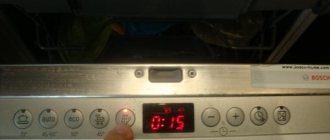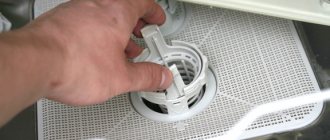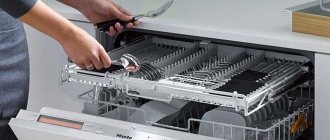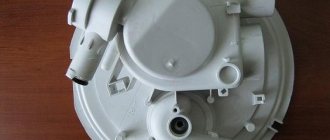What is the water consumption of a dishwasher?
The range of dishwashers presented by different manufacturers includes narrow, compact and full-size options that differ, among other characteristics, in chamber capacity. We can say that water consumption depends on this indicator.
For 60 cm
Full-size dishwashers can clean 10 to 14 sets of dishes in one cycle and use 9-14 liters of water. Some expensive full-size PMMs consume only 6.5-7 liters, depending on technical capabilities.
A small family should not purchase a machine with a large chamber, so as not to waste excess water. Having dirty dishes pile up for days is not very pleasant, and it can also lead to a bad smell in your car.
For 45 cm
As a rule, water consumption in narrow PMM models of different brands is small - up to 9 liters per working cycle. This technique can accommodate up to 9 sets of dishes and consumes 0.69 kWh during the normal program, which lasts an average of 205 minutes.
The best dishwashers 40 and 65 cm
Modern manufacturers of dishwashing equipment strive to make their products more economical and functional. Here are several models with minimal water and electricity consumption that you should pay attention to when choosing.
- Bosch SMV69T70 is a full-sized built-in machine designed to wash 14 standard sets of dishes. For a full operating cycle, which lasts 140 minutes, it consumes 9.5 liters of water and 0.74 kW/h of electricity.
- Bosch SMS40L02 is a free-standing machine with a width of 60 cm and consumes 12 liters of water. In terms of energy consumption it belongs to class A.
- Hotpoint-Ariston LTF 11S111 is a spacious dishwasher designed to clean 15 sets of dishes. For a full cycle it consumes 11 liters of water resources and 1.07 kWh of energy.
- Zanussi ZDV 91500 FA is a narrow built-in dishwasher that will wash 9 sets in one cycle, using 9 liters of water and 0.9 kWh of electricity.
- Whirlpool ADG 422 is a stylish 45 cm wide model, built under the countertop, that can easily handle 10 sets of utensils, using 9 liters of water for cleaning. Energy saving class A+.
A dishwasher is a wonderful purchase in every way. In addition to the fact that this modern device significantly reduces the cost of washing dishes, consuming a minimal amount of water and very little energy, it has many other advantages. The main thing is to save the housewife’s time and effort. Having such an assistant in the kitchen, you won’t have to stand at the sink three times a day doing monotonous work. High quality dishwashing is also an advantage of this wonderful device. Few hands can withstand the effects of water heated to +70°C in combination with detergent. But this is exactly the environment that is created inside the loading tank when the machine is operating.
Additional bonuses
In addition to the fact that the machine significantly saves water, its use brings some additional bonuses:
- The high temperature of washing dishes in the machine (in some models it can reach 90°C) will ensure almost complete sterilization of the dishes. This advantage will be appreciated primarily by families with infants. True, reaching such high temperatures will increase electricity consumption and reduce savings.
- The use of softening conditioners when washing will ensure impeccable cleanliness of the walls of glassware, which is unattainable in regions with hard water by any other method.
- As with washing machines, the principle applies: the larger the volume of the dishwasher, the greater the water savings achieved per cycle.
We recommend: How much water and electricity does a dishwasher use per cycle?
The main bonus, without a doubt, is the time saved. Of course, before loading the dishes into the machine, you will have to clean the dishes from large solid pieces of food, sort them and carefully place them in brackets. But this will take no more than 15 minutes, and the rest of the time can be devoted to other household chores, relaxation or hobbies.
Compact PMM
The washing chamber of compact dishwashers can accommodate 6-8 sets of dishes. At the same time, the machines consume the same amount of water as narrow or full-size economical versions - 6.5-9 liters. It turns out that the same amount of resources is consumed, and less dishes are washed.
But still, consumption depends to a greater extent on such design characteristics as efficiency than on dimensions and capacity. The more efficiently a technology saves resources, the higher its cost.
4 SKS62E88
By mode
Water consumption during machine washing depends on the selected program. The half-load mode allows you to reduce water costs by 20-30%.
The function of intelligent load assessment, provided in the premium PMM, is that the device automatically determines the required volume of water depending on the amount and degree of soiling of the dishes.
Manufacturers equip their equipment with different programs and options, but water is consumed approximately as follows:
- “Light pollution” will require 7 liters.
- In “Economic” mode, 8-9 liters will be spent.
- The “Auto” option assumes consumption of 6-11 liters.
- With “Intensive” washing, resource costs will increase to 10-11 liters.
By brand
Each manufacturer produces PMMs with different characteristics, but in general all companies strive to minimize water costs using innovative solutions. If we summarize the performance of dishwashers of different brands, the average water consumption of the appliance can be represented as follows:
- Bosch - about 10 l;
- Siemens – 7 l;
- Candy – 8-13 l;
- Beko – up to 12 l;
- Electrolux – up to 10 l;
- Indesit – 7 l.
- Ariston - 8-10 l.
hsie 2b19
What does consumption depend on?
The water consumption of a dishwasher is not a fixed indicator. Consumption directly depends on the modification, additional functions and water consumption class. The entire variety of existing models can be divided into three categories.
- Compact desktop machines with low load. Such models consume from 7 to 10 liters per cycle.
- Medium household: built-in narrow or full-size, free-standing. Narrow models have a smaller loading volume, from 6 to 8 sets, while full-size ones can hold up to 14 sets of dishes. Such equipment will consume from 10 to 14 liters per wash cycle.
- Large units designed for large loads, which are used in restaurants, cafes and canteens. Depending on the load volume, such dishwashers consume from 20 to 25 liters.
How savings are achieved
The dishwasher uses water more economically thanks to the following operating features:
- The water in the device is reused many times, purified using filters.
- Water is sprayed under high pressure.
Water in the PMM is used at three stages:
- pre-spraying;
- main washing cycle;
- rinsing.
After completing the first operation, the machine does not drain the water into the sewer, but passes it through a filtration system and reuses it. After washing dirty dishes, the equipment partially drains the liquid and adds a fresh portion from the water supply to the remainder.
Expert opinion
I work in the household appliance repair industry. Extensive experience in restoring washing machines and dishwashers.
Thanks to the high flow rate of water from the sprinklers, the quality of washing dishes is improved and the process is accelerated, as well as resource consumption is reduced.
Download mode
Most modern models have a half-load function, which allows you to not only wash half as many dishes, but also consume half as much liquid and electricity. Of course, even in a machine without such a function, you can wash an incomplete volume of dishes. It’s just that the same amount of water and electricity will be spent as when the tank is fully loaded.
The partial loading function is present in all advanced models from Bosch, Ariston, Whirlpool and other manufacturers. In addition, some expensive dishwashers have built-in special water flow sensors that control the volume of incoming liquid depending on the amount of dishes and the degree of soiling.
Saving time - we calculate costs
In one working cycle, which includes washing and drying, the dishwasher is capable of washing 9 sets of dirty dishes . Or 4 sets and kitchen utensils that were used for cooking. This takes 2 hours. When washing by hand, this amount of dishes takes from 30 minutes to 1 hour.
When the technology is working, free time is spent on other things. It only takes a few minutes to clear the dishes from leftover food, load them into the machine, and then place the clean ones on the shelves.
Thus, we make an average calculation. If you calculate that dishes are washed by hand once a day, spending 60 minutes on it, then a year comes out to 21,900 minutes (60 minutes x 365 days). This is 365 hours (21900 minutes: 60 minutes), or approximately 15 days (365 hours: 24 hours).
Are there savings?
Now let’s analyze, if the difference is in how much water a dishwasher spends and how much a person spends on washing the same amount of dishes, does the machine actually save water or not? You can only talk about saving water consumption if you have water meters; if you don’t have them, then the water consumption of the dishwasher doesn’t matter.
If we take, for example, a narrow Siemens SN 66M094 dishwasher with a capacity of 14 sets and load 63 items into it, for example:
- 18 plates,
- 14 cups,
- 2 pans,
- 3 salad bowls,
- 1 cutting board,
- 1 teapot,
- 24 cutlery,
then in about three hours with intensive mode it will spend 10 liters of water.
We tried to wash half of the set of dishes that the dishwasher washed, that is, 34 items. The whole process took 20 minutes. At the same time, the water was turned off when the dishes needed to be washed. As a result, 23 liters of hot and 20 liters of cold water were spent, a total of 43 liters. For just one wash, the figure seems impressive.
If we convert the savings from liters to rubles, this is what we got: for 1 year of daily operation of the machine, you can save 8280 liters, the average cost of hot water for 2021 in Moscow is 130 rubles. This means that the dishwasher saves 1,076 rubles in your budget on hot water. Savings on cold water will be 108 rubles.
Conclusion! A dishwasher will save 1,184 rubles on water per year. But this is subject to the economical use of water when washing by hand; there are those who spend 100 liters of water a day washing dishes, which means that the machine will save even more.
Of course, this is a small amount, and in order to talk about real savings, you also need to calculate the electricity consumption and the cost of detergents. As for electricity, water savings cover electricity consumption by about 3-4 times. There will be about 830 rubles left for detergents. This money may not be enough for a year, depending on what to wash and what to sprinkle, but we can say that the total costs of hand and machine washing are approximately equal. However, there is still a big advantage in favor of a dishwasher; it will save you time, which you can spend with pleasure.
Thus, even according to the most conservative estimates (with a water consumption of 14 liters), the dishwasher saves water. But whether your family budget saves or not, calculate for yourself. Everything will depend not so much on the model of the machine, but on what detergents you use to wash dishes. In our opinion, are these costs worth a few minutes of rest after work?
Interesting:
- Dishwasher rating 45 cm
- Dishwasher power in kW
- Is it worth buying a dishwasher?
- Review of narrow built-in dishwashers
- Which company to choose and buy a dishwasher
- Which dishwasher is better - Bosch, Siemens,...
Reader comments
- Share your opinion - leave a comment
Dependence of water consumption on the modes and parameters of the “dishwasher”
According to the degree of efficiency, “dishwashers” are divided, according to the standard adopted in Europe, into 7 classes. Classes are designated by letter (from A to G) or alpha-symbolic markings (from A+++ to D), where proximity to the beginning of the alphabet and a greater number of pluses means a higher class with low consumption.
The water consumption of a dishwasher is also affected by its type. Cars are:
- Full size with loading for 12-14 sets. and water consumption 12-14 l.
- Narrow for 9-10 sets. and consumption of 9-10 liters.
- Compact for 6-8 sets. with a flow rate of 7-9 l.
But these ratios are adjusted by the “half load” function with a reduction in water consumption by 20-30% or by the “intelligent assessment” function of the device’s load. In this case, the dishwasher itself determines what water consumption per cycle will be most efficient without compromising quality. Such features are most often found in full-size and narrow models or in premium compact units. The full functionality and choice of modes is determined by the manufacturer, but some of the popular ones include:
- Auto mode. Cleans all types of dishes, including pans and pots, with pre-wash, rinse and dry. Consumption for 3rd class – 6-11 l.
- Economy mode. Copes with normal soiling at a temperature of about 50°C and a consumption of 8-9 liters.
- Heavy soiling (Intensive mode). It increases water consumption (up to 10-11 l) and temperature (up to 70°C).
- Fresh contamination. It does without pre-washing, and the main wash takes place at a temperature of 55-60°C with an economical consumption of 7 liters.
- Duo Wash. A specific mode in devices from some manufacturers, in which you can simultaneously wash heavily soiled dishes and those that require the use of a delicate mode.
- OptoSensor. Function with selection of water hardness.
Comparison with hand washing
In addition to the fact that the dishwasher uses water repeatedly and therefore consumes a small volume, the device only draws cold water for its operation, heating it to the desired temperature. This solution is cheaper for the user.
Even if you take into account the energy consumption for heating, this method will still be cheaper than using hot water. In addition, hot water from the tap is dirtier; its impurities can quickly clog PMM filters.
Practice shows that when washing the same volume of dirty dishes, a machine consumes 10 times less water than the housewife using the manual method. At the same time, self-washing involves the use of more expensive hot water.
When washing dishes by hand, up to 100 liters of mixed water goes down the drain. The appliance will clean the same number of kitchen utensils, spending approximately 10 liters. Consumption depends on the model and selected mode.
Experts believe that a dishwasher pays for itself within 4 years on average. Household appliances stores regularly hold promotions and make attractive offers to customers.
Advantages of dishwashing appliances
The main advantages of a dishwasher (DMM) include saving time and effort that would be spent on manual washing. The equipment is easy to use. Dirty dishes are loaded into it, detergent is added, the desired mode is selected, a button is pressed and the process starts.
A dishwasher saves water by using much less water than washing the same amount of utensils by hand. At the same time, the quality of washing in a machine is much higher, since it uses special detergents and very hot water (from 70 to 90 ℃). Heating to 90℃ practically means sterilizing the utensils. This is especially true for families with small children.
The washing process in a dishwasher occurs under pressure. As a result, graters, colanders, and spatulas are washed well. Grease and carbon deposits are washed off from pots, pans and baking sheets. The equipment is also used to clean barbecue grills, gas burners from stoves, baking dishes and other kitchen utensils.
The dishwasher has a drying function. Therefore, after washing, the dishes are not wiped, but only put in their places.
In addition to its advantages, the technology has its disadvantages:
- The unit consumes electricity.
- To ensure that kitchen utensils are thoroughly washed, they are first cleared of food and placed correctly.
- The dishwasher requires periodic washing and cleaning. To do this, run idle cycles. They also clean the pump and filter.
Advice. When purchasing a new appliance, consider in advance how many dishes you expect to use, so that a full-size model does not become a warehouse for smelly, dirty dishes.
Will a dishwasher help you save on water?
We calculate in which cases it is more profitable to wash dishes by hand, and when it is better to resort to the benefits of civilization.
– There are often advertisements for dishwasher detergent on TV, in which they claim that this miracle unit will help you significantly save on water. Is this really true?
To calculate costs, the portal's editors conducted a small experiment: we compared water meter readings before and after washing dishes. Of course, the number of people in a family is different for everyone, as is the number of dishes. But there are also general points. So, in addition to a set of dishes for each family member (plate, mug, fork or spoon), there are also related items: pots, pans, their lids, cutting boards, knives, etc., and cold and hot water (for those who do not have it turned off ) are spent approximately equally.
It is also worth considering that in winter, as a rule, we use more hot water than in summer, and tariffs in different areas of the city may differ. Thus, in the Novovyatsky district the cost of a cubic meter of cold water is 33.66 rubles, in Kirov - 28.42 rubles. In addition, we do not take into account the cost of dishwashing detergents - neither for the “manual” method, nor for the dishwasher. Our calculations will only concern water costs.
To wash the dishes after dinner for a family of two, it took 35 liters of water: 18 liters of cold and 17 liters of hot. The Kirov tariff for hot water is 163.98 rubles per cubic meter, for cold water - 28.42 rubles. In addition, you need to take into account the costs of sewerage at a tariff of 21.80 rubles. per cubic meter.
Let's do the math:
0.017x163.98 + 0.018x28.42 + 0.035x21.80 = 4.06 rubles
That's how much we spent on washing two sets of dishes.
Now let's move on to dishwashers. Water consumption will depend on the model and year of its manufacture: older cars consume more water than
On this topic
Will a water heater help you save on hot water?
8354
new models, but, as a rule, costs do not exceed 20 liters, and this is in the most uneconomical option. For modern dishwashers, 6.5 liters per cycle is sufficient. In addition, the selected mode also affects water consumption: for severe pollution, an intensive mode is used, which requires more water. On average, a small dishwasher (about 45 cm wide) can fit about nine sets of dishes, and if you are willing to leave unwashed cups and plates until the evening, you can wash all the dishes that have accumulated during the day in one go.
To calculate the cost of water for a dishwasher, we took average figures: 10 liters of cold water (it is heated directly in the machine).
0.010x28.42 + 0.010x21.80 = 0.5 ruble
It turns out that a dishwasher is more than 8 times more economical than the usual “manual” method.
It’s also worth noting that our little experiment was conducted on a weekday evening. On weekends, when you have breakfast, lunch and dinner at home, a lot more dishes get dirty. Accordingly, water consumption increases.
However, this “pure” comparison did not take into account energy costs. And in the case of a dishwasher, they are significant, because it has to heat the water itself.
A small dishwasher with 6 sets consumes approximately 0.6 kWh per cycle. The electricity tariff in Kirov from July 2021 is 3.95 rubles/kWh.
0.6x3.95 = 2.37 rubles
Thus, the total cost of water and electricity per cycle for the dishwasher will be
2.37 + 0.5 = 2.87 rubles
In total, according to our calculations, it turned out that with a dishwasher we save approximately 1.69 rubles per day. However, we note once again that for the calculation we took two sets of dishes and the cost of water for washing them only once a day. In the case of a “wholesale” load of the dishwasher, the savings will be 2-3 times higher.
We also decided to calculate how long it would take for such savings to pay for a dishwasher. On the websites of Kirov household appliance stores, prices range from 15 to 130 thousand rubles (excluding all kinds of promotions and discounts). A machine worth 15 thousand will pay for itself in 8,876 washes, and the most expensive unit - in 76,924 times. If we translate this into time indicators (when calculating 2 dishes per day), it turns out that the cheapest dishwasher will pay for itself in 12 years, and the most expensive one in 105. Frankly speaking, not quickly.
Briefly about the main thing:
1. To calculate costs, we took two sets of dishes with other kitchen utensils. Only one wash per weekday was taken into account.
2. The water and electricity consumption of a dishwasher depends on its capacity and year of manufacture. Given the total costs, such equipment will not pay for itself quickly.
3. Costs directly for water with the “manual” method of washing dishes exceed the costs of a dishwasher by more than 8 times.
If you have questions that you can't find the answer to, ask us and we will try to answer them.
Photo: propositive.ru
On this topic
2391
What to do if the deadline for major home repairs is constantly being postponed?
Calculation of savings in money
The annual water consumption for washing dishes is as follows:
- in the car - 10 l * 365 days = 3650 l of cold water;
- manually – 100 l * 365 days = 36500 l of mixed water.
Let's assume that the cost of a cubic meter of resource in the user's region is:
- cold water supply – 20 rub./m³;
- hot water supply – 70 rub./m³.
Let's calculate the annual water consumption in monetary terms:
- PMM – 3,650 m³ * 20 rub./m³ = 73 rub.
- Manual washing – 36,500 m³ * 70 RUR/m³ = 2555 RUR.
Obviously, using kitchen appliances brings big savings. This calculation does not take into account the difference in the cost of detergents: tablets, rinse aid and special salt for water softening.
Does it save water?
An analysis of the indicators of hot and cold water supply meters suggests that in one “session” of manual washing in the described mode, about 70–75 liters of hot water and 30–40 liters of cold water are spent. Of course, this amount can be reduced somewhat if you periodically open and close the water (for example, while washing dishes). However, such savings will increase the procedure time and require more effort.
We recommend: Is it possible to clean a dishwasher with citric acid: pitfalls
According to the instructions for the dishwasher taken as a comparison object, the consumption per cycle should be approximately 9 liters of cold water. The actual consumption (as determined by the meter) was 10 liters.
Water consumption is significantly affected by its hardness. Soft water (containing few Ca and Mg ions) washes detergents less well, so it is consumed in large quantities. At the same time, hard water shortens the life of the machine.
Calculating the cost of washing dishes in the selected modes gave the cost of one hand wash - 15.4 rubles, and machine washing - 5.5 rubles. The following tariffs were used for calculations:
- 1 cu. m of hot water including drainage – 178.19 rubles.
- 1 cu. m of cold water including drainage – 57.12 rubles.
- 1 kW of electricity during the day – 3.71 rubles. (at night the cost of 1 kW is 2.07 rubles, so if you start the car at night, one cycle will cost about 3 rubles.)
If we assume that we wash dishes in this mode once a day, then we will spend 5.5 thousand rubles on hand washing in a year. Using the machine will save almost 3.5 thousand rubles.
Expert advice
When choosing a dishwasher in a store, pay attention to such indicators as:
- washing class;
- Economy mode and half load option available.
The operation of class A appliances is characterized by the lowest water consumption. According to this indicator (from A to G), dishwashers are divided into:
- economical;
- average degree of efficiency;
- low-cost.
In recent years, kitchen appliance manufacturers have been producing devices that use water resources as efficiently as possible.
Special modes will help reduce the amount of water consumed:
- economical;
- for light contamination;
- half load.
Remember also that proper placement of dishes will ensure ideal washing results and make it possible to reduce water consumption. Recommendations for the distribution of kitchen utensils in the washing compartment can be found in the user manual.
There are many benefits of using a dishwasher in your home. In addition to saving time and the ability to go about their business, the user receives a reduction in water consumption. The technology uses an expensive resource efficiently and repeatedly.











